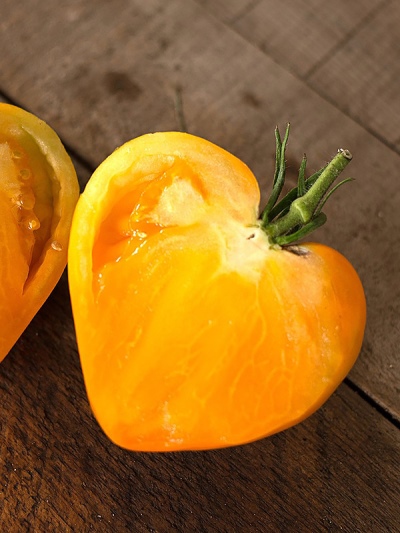
- Authors: Kandoba E. E., Kandoba A. V., LLC 'PREMIUM SIDS'
- Year of approval: 2015
- Name synonyms: Honey Heart
- Category: grade
- Growth type: determinant
- Appointment: fresh consumption
- Ripening period: early
- Ripening time, days: 90-94
- Growing conditions: for open ground, for film greenhouses
- Bush size: undersized
Honey heart is a healthy and tasty tomato variety that has been pleasing gardeners for many years with its unpretentious care and, of course, a generous harvest.
Breeding history
The authors of this orange miracle were Kandoba Elena Evgenievna and Kandoba Aleksey Viktorovich, breeders of Premium Seeds LLC. The company applied for inclusion in the register and admission to the use of the culture in December 2014, and already in 2015 the variety was included in the State Register of the Russian Federation. A synonym for the name is Honey Heart.
Description of the variety
The culture has a determinant type of growth, therefore it is undersized, growing up to a maximum of 70 centimeters. The leaves on a bush are medium in size, colored green. The culture is distinguished by an intermediate inflorescence. Honeyheart tomatoes are not susceptible to cracking, they can be transported at any distance. At the same time, they can perfectly ripen at home on the windowsill, without losing their high qualities of taste and aroma. Other advantages include:
- high productivity;
- no need for tying, pinching;
- universal use;
- compact bushes can be grown in a small area;
- strong immunity.
And the only disadvantages can be identified only that growing culture will not be within the power of novice agrarians. And the plant is quite demanding in relation to the selection of soil - the soil needs to be fertile.
The main qualities of the fruit
A green tomato, when unripe, turns bright orange when ripe. The shape of the tomatoes is heart-shaped, which is reflected in the name. Fruit weight is not very large, on average 100-150 grams. The skin is smooth, the flesh is of medium density, with 4 to 6 seed nests.
Taste characteristics
A distinctive feature of the Honey Heart tomato variety is a large amount of useful substances in the composition of the fruits, which are very fleshy and juicy, sugary like honey. So, in orange fruits there is a lot of beta-carotene, therefore, such vegetables are often used in dietary nutrition.
Ripening and fruiting
The tomato ripens early, in just 90-94 days (counting from seed germination to fruit emergence), so the variety is classified in the early maturing category.
Yield
The honey heart has a fairly high yield. Under the film, the variety can bring from 8.6 to 9 kilograms per square meter.
The timing of planting seedlings and planting in the ground
In March, seed material is sown for seedlings, while maintaining a depth of 2-3 cm. As a rule, the seeds are treated with potassium permanganate, and then washed in clean running water. Mandatory picking at the stage of one or two true leaves.
During cultivation, seedlings should be fed about 2-3 times with complex fertilizers. Before planting in a permanent place, young plants are hardened, starting to do this in advance, 7-10 days in advance. You can transplant grown tomatoes to a garden bed or to a greenhouse from mid-May to early June.

Growing tomato seedlings is an extremely important process, because it largely depends on whether the gardener will be able to harvest at all. All aspects must be taken into account, from seedbed preparation to planting in the ground.
Landing scheme
Small bushes are grown very compactly. So, the planting has a density of 7-9 shoots per square. Recommended landing pattern:
- between the rows - 40 cm;
- between bushes - 70 cm.
Too much thickening of the plants will have a bad effect on future yields.

Growing and care
A honey heart does not need to form a stem. Water the plants regularly and mainly with warm water. For the entire growing season, it is necessary to carry out from two to three dressings. At the same time, it is worth providing the culture with fertile soil.
The variety is light-requiring. The culture grows well in the south and without film shelters. And for growing in the middle lane, it is better to use greenhouses. Gardeners from the northern regions are advised to choose earlier maturing varieties. Alternatively, you can try to nurture a Honey Heart at home. These plants are ideal for growing in pots or flowerpots anywhere on the balcony / loggia.
Care is quite simple and does not cause any particular difficulties: this is fertilizing with mineral fertilizers and organic matter, the subsequent loosening of the soil around the trunks, watering moderately, only with warm water, breaking off the lower leaves.
As already mentioned, pinning, as well as tying up the trunk, in most cases is not necessary. However, if necessary, you can install small props under the heavy branches, hung with fruits.




A plant needs different micronutrients at each stage of growth. All fertilizers can be divided into two groups: mineral and organic. Folk remedies are often used: iodine, yeast, bird droppings, eggshells.
It is important to observe the rate and period of feeding. This also applies to folk remedies and organic fertilizers.



























































































